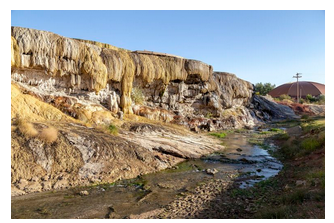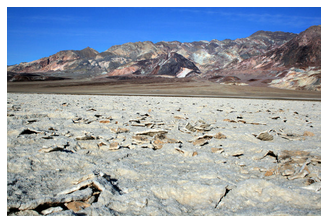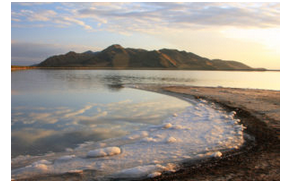7.3.2: Chemical Sedimentation
- Page ID
- 18690
\( \newcommand{\vecs}[1]{\overset { \scriptstyle \rightharpoonup} {\mathbf{#1}} } \)
\( \newcommand{\vecd}[1]{\overset{-\!-\!\rightharpoonup}{\vphantom{a}\smash {#1}}} \)
\( \newcommand{\id}{\mathrm{id}}\) \( \newcommand{\Span}{\mathrm{span}}\)
( \newcommand{\kernel}{\mathrm{null}\,}\) \( \newcommand{\range}{\mathrm{range}\,}\)
\( \newcommand{\RealPart}{\mathrm{Re}}\) \( \newcommand{\ImaginaryPart}{\mathrm{Im}}\)
\( \newcommand{\Argument}{\mathrm{Arg}}\) \( \newcommand{\norm}[1]{\| #1 \|}\)
\( \newcommand{\inner}[2]{\langle #1, #2 \rangle}\)
\( \newcommand{\Span}{\mathrm{span}}\)
\( \newcommand{\id}{\mathrm{id}}\)
\( \newcommand{\Span}{\mathrm{span}}\)
\( \newcommand{\kernel}{\mathrm{null}\,}\)
\( \newcommand{\range}{\mathrm{range}\,}\)
\( \newcommand{\RealPart}{\mathrm{Re}}\)
\( \newcommand{\ImaginaryPart}{\mathrm{Im}}\)
\( \newcommand{\Argument}{\mathrm{Arg}}\)
\( \newcommand{\norm}[1]{\| #1 \|}\)
\( \newcommand{\inner}[2]{\langle #1, #2 \rangle}\)
\( \newcommand{\Span}{\mathrm{span}}\) \( \newcommand{\AA}{\unicode[.8,0]{x212B}}\)
\( \newcommand{\vectorA}[1]{\vec{#1}} % arrow\)
\( \newcommand{\vectorAt}[1]{\vec{\text{#1}}} % arrow\)
\( \newcommand{\vectorB}[1]{\overset { \scriptstyle \rightharpoonup} {\mathbf{#1}} } \)
\( \newcommand{\vectorC}[1]{\textbf{#1}} \)
\( \newcommand{\vectorD}[1]{\overrightarrow{#1}} \)
\( \newcommand{\vectorDt}[1]{\overrightarrow{\text{#1}}} \)
\( \newcommand{\vectE}[1]{\overset{-\!-\!\rightharpoonup}{\vphantom{a}\smash{\mathbf {#1}}}} \)
\( \newcommand{\vecs}[1]{\overset { \scriptstyle \rightharpoonup} {\mathbf{#1}} } \)
\( \newcommand{\vecd}[1]{\overset{-\!-\!\rightharpoonup}{\vphantom{a}\smash {#1}}} \)
\(\newcommand{\avec}{\mathbf a}\) \(\newcommand{\bvec}{\mathbf b}\) \(\newcommand{\cvec}{\mathbf c}\) \(\newcommand{\dvec}{\mathbf d}\) \(\newcommand{\dtil}{\widetilde{\mathbf d}}\) \(\newcommand{\evec}{\mathbf e}\) \(\newcommand{\fvec}{\mathbf f}\) \(\newcommand{\nvec}{\mathbf n}\) \(\newcommand{\pvec}{\mathbf p}\) \(\newcommand{\qvec}{\mathbf q}\) \(\newcommand{\svec}{\mathbf s}\) \(\newcommand{\tvec}{\mathbf t}\) \(\newcommand{\uvec}{\mathbf u}\) \(\newcommand{\vvec}{\mathbf v}\) \(\newcommand{\wvec}{\mathbf w}\) \(\newcommand{\xvec}{\mathbf x}\) \(\newcommand{\yvec}{\mathbf y}\) \(\newcommand{\zvec}{\mathbf z}\) \(\newcommand{\rvec}{\mathbf r}\) \(\newcommand{\mvec}{\mathbf m}\) \(\newcommand{\zerovec}{\mathbf 0}\) \(\newcommand{\onevec}{\mathbf 1}\) \(\newcommand{\real}{\mathbb R}\) \(\newcommand{\twovec}[2]{\left[\begin{array}{r}#1 \\ #2 \end{array}\right]}\) \(\newcommand{\ctwovec}[2]{\left[\begin{array}{c}#1 \\ #2 \end{array}\right]}\) \(\newcommand{\threevec}[3]{\left[\begin{array}{r}#1 \\ #2 \\ #3 \end{array}\right]}\) \(\newcommand{\cthreevec}[3]{\left[\begin{array}{c}#1 \\ #2 \\ #3 \end{array}\right]}\) \(\newcommand{\fourvec}[4]{\left[\begin{array}{r}#1 \\ #2 \\ #3 \\ #4 \end{array}\right]}\) \(\newcommand{\cfourvec}[4]{\left[\begin{array}{c}#1 \\ #2 \\ #3 \\ #4 \end{array}\right]}\) \(\newcommand{\fivevec}[5]{\left[\begin{array}{r}#1 \\ #2 \\ #3 \\ #4 \\ #5 \\ \end{array}\right]}\) \(\newcommand{\cfivevec}[5]{\left[\begin{array}{c}#1 \\ #2 \\ #3 \\ #4 \\ #5 \\ \end{array}\right]}\) \(\newcommand{\mattwo}[4]{\left[\begin{array}{rr}#1 \amp #2 \\ #3 \amp #4 \\ \end{array}\right]}\) \(\newcommand{\laspan}[1]{\text{Span}\{#1\}}\) \(\newcommand{\bcal}{\cal B}\) \(\newcommand{\ccal}{\cal C}\) \(\newcommand{\scal}{\cal S}\) \(\newcommand{\wcal}{\cal W}\) \(\newcommand{\ecal}{\cal E}\) \(\newcommand{\coords}[2]{\left\{#1\right\}_{#2}}\) \(\newcommand{\gray}[1]{\color{gray}{#1}}\) \(\newcommand{\lgray}[1]{\color{lightgray}{#1}}\) \(\newcommand{\rank}{\operatorname{rank}}\) \(\newcommand{\row}{\text{Row}}\) \(\newcommand{\col}{\text{Col}}\) \(\renewcommand{\row}{\text{Row}}\) \(\newcommand{\nul}{\text{Nul}}\) \(\newcommand{\var}{\text{Var}}\) \(\newcommand{\corr}{\text{corr}}\) \(\newcommand{\len}[1]{\left|#1\right|}\) \(\newcommand{\bbar}{\overline{\bvec}}\) \(\newcommand{\bhat}{\widehat{\bvec}}\) \(\newcommand{\bperp}{\bvec^\perp}\) \(\newcommand{\xhat}{\widehat{\xvec}}\) \(\newcommand{\vhat}{\widehat{\vvec}}\) \(\newcommand{\uhat}{\widehat{\uvec}}\) \(\newcommand{\what}{\widehat{\wvec}}\) \(\newcommand{\Sighat}{\widehat{\Sigma}}\) \(\newcommand{\lt}{<}\) \(\newcommand{\gt}{>}\) \(\newcommand{\amp}{&}\) \(\definecolor{fillinmathshade}{gray}{0.9}\)
Chemical weathering yields dissolved material that water transports until precipitation of chemical sediment occurs. Several things may cause precipitation; the most common causes are evaporation, changes in temperature or acidity (pH), and biological activity. For example, hot springs deposit a form of calcite called travertine when cooling water becomes oversaturated with CaCO3. This photo (Figure 7.14) shows thick travertine terraces deposited by hot springs in Wyoming.
In freshwater streams or lakes, a pH change due to biological activity may cause precipitation of another form of calcite called marl. In marine settings, many reef-building organisms have shells or skeletons made of organic calcite. So, living organisms are the prcipitating agents. Calcite and other chemical sedimentary minerals, then, precipitate in many ways. In contrast with clastic sediments, chemical sediments usually lithify at the same time they precipitate.

Natural waters contain dissolved minerals, and all minerals are soluble in water to some extent. Halides, many sulfates, and other salts have very high solubilities. Carbonate minerals, including calcite and dolomite, have moderate solubilities. Silicate minerals have relatively low solubilities. If water evaporates, it may become oversaturated in particular minerals and deposit chemical sediments, such as the salt deposits in the photo seen here (Figure 7.15). Precipitation will continue, decreasing concentrations of dissolved material, until the solution and sediments achieve equilibrium. Because of their high solubility, large amounts of evaporation may be necessary before salts such as halite, precipitate. In contrast, carbonate minerals (calcite and dolomite) and silica often precipitate early during evaporation. Silica (SiO2), in the form of chert, is the only silicate mineral that commonly forms a chemical sedimentary rock.
Gypsum (CaSO4•2H2O), anhydrite (CaSO4), halite (NaCl), and sylvite (KCl) consist of common elements. Ggypsum and anhydite have high solubilities; halite and sylvite have even higher solubilities. So, their chemical components are common as dissolved species. As water evaporates, perhaps in a closed inland basin or an isolated sea, these four minerals may precipitate to form thick beds of evaporite minerals. Besides these minerals, many other (less common) minerals also occur in evaporites. Evaporites are found in many parts of the world. Geologists estimate that thick evaporite beds, at some depth, underlie 35% of the United States.

Figure 7.16 shows the Trona Pinnacles in Searles Lake, a southern California playa lake. Some of the pinnacles rise more than 40 m above the lakebed. These pinnacles consist of trona (a hydrated sodium carbonate) that precipitated from briny water. Like all playas, this lake is dry most of the time. But, past flooding and subsequent evaporation produced thick layers of evaporite minerals. More than 25 different minerals are found in the Searles Lake sediments. The list includes sodium and potassium carbonates, sulfates, borates, and halides. Borax (hydrated sodium borate), trona, and several other minerals are profitably mined from Searles Lake sediments today.
Most evaporite minerals are rare at Earth’s surface because they are so soluble that they dissolve away in all but the most arid climates. Gypsum is the most common evaporite in outcrops because it is less soluble than others, and because it forms from any anhydrite exposed at or near Earth’s surface. In the subsurface, massive gypsum and halite beds are common, as are the salt domes found in Texas and other Gulf Coast areas of the United States. Although generally dominated by just a few minerals, many other minerals may be present. In all, petrologists have reported nearly 100 minerals from evaporites. Less than a dozen are common.

Evaporites may be marine deposits associated with evaporation of ocean water. They may also be non-marine, associated with freshwater lakes or other continental waters. For water to become oversaturated, a water body must be somewhat isolated and the evaporation rate must be faster than any water flowing in. This is most common in an arid environment. For example, at various times in the past, the Mediterranean Sea has been cut off from an ocean. Evaporation led to thick salt deposits that lie beneath the Mediterranean today. And today, evaporite minerals are collecting along the shores of the Dead Sea between Jordan and Israel (see Figure 7.1, the opening figure in this chapter), on the shores Utah’s Great Salt Lake (Figure 7.17), and around many other isolated water bodies.
| Some of the Most Common Evaporite Minerals | ||
| mineral group | mineral name | chemical |
| chlorides | halite sylvite bischofite kainite carnallite |
NaCl KCl MgCl2•6H2O KMg(SO4)Cl•3H2O KMgCl3•6H2O |
| sulfates | anhydrite gypsum barite thenardite mirabilite kieserite langbeinite polyhalite kainite epsomite |
CaSO4 CaSO4•2H2O BaSO4 Na2SO4 Na2SO4• 10H2O MgSO4•H2O K2Mg2(SO4)3 K2Ca2Mg(SO4)4•2H2O KMg(SO4)Cl•3H2O MgSO4•7H2O |
| carbonates | dolomite calcite magnesite trona |
CaMg(CO3)2 CaCO3 MgCO3 Na3(HCO3)(CO3)•2H2O |
| borate | borax | Na2B4O7•10H2O |
As ocean water evaporates, minerals precipitate in predictable order from those that are least soluble to those that are most soluble. Calcite is first, followed by gypsum, anhydrite, and then halite. Many other minerals may precipitate in lesser amounts. Continental water contains different dissolved solids than marine water, so continental evaporites contain different minerals than marine evaporites. Water chemistry is also quite variable, so many different minerals are possible.
Continental evaporite deposits may contain halite, gypsum, and anhydrite but also typically have borax, trona, and many other non-marine salts. The table lists some minerals reported from evaporite deposits in North America. It is a long list.
this is a blank li


